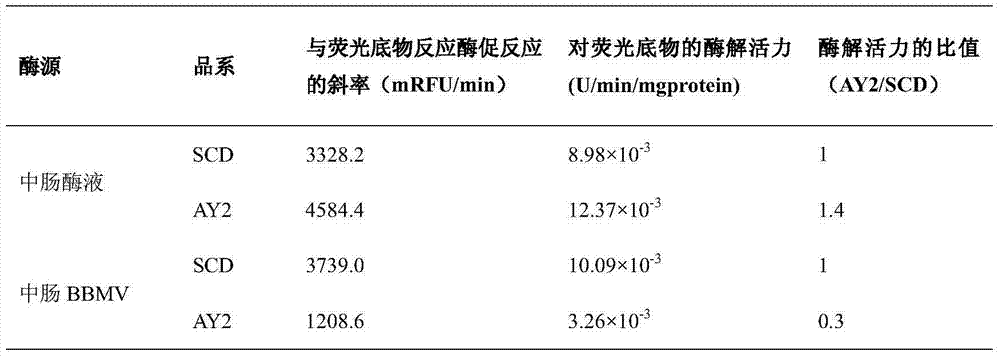Fluorescent substrate for detecting activity of trypsin acting on Cry1A protoxin and application of fluorescent substrate
A technology of trypsin and protoxin, applied in the biological field, can solve problems such as lack of pertinence, low sensitivity, and inability to directly elucidate the effect, and achieve the effects of clear specificity and pertinence, improved sensitivity, and great practical value
- Summary
- Abstract
- Description
- Claims
- Application Information
AI Technical Summary
Problems solved by technology
Method used
Image
Examples
Embodiment 1
[0027] The first step: extract the enzyme liquid of the midgut of the larvae of Lepidoptera insects.
[0028] Taking the Lepidoptera insect cotton bollworm as an example, take the 5th instar larva of the cotton bollworm on the second day, put it on ice for 30 minutes, cut off the head and tail with a scalpel, and pick up the midgut (including the contents) with tweezers The midguts of each 3-5 test worms were combined as a sample, and 1ml of pre-cooled 0.15M sodium chloride solution was added, homogenized in an ice bath, and then the homogenate was transferred to a centrifuge tube and centrifuged for 15 minutes (12,000g, 4°C) , take the supernatant as the enzyme source, and store it at -20°C for future use.
[0029] The second step: extracting the BBMV from the midgut of the larvae of Lepidoptera insects.
[0030] Taking the Lepidoptera insect cotton bollworm as an example, take the 5th instar larva on the second day of the cotton bollworm, put it on ice for 30 minutes, remov...
PUM
 Login to View More
Login to View More Abstract
Description
Claims
Application Information
 Login to View More
Login to View More - R&D
- Intellectual Property
- Life Sciences
- Materials
- Tech Scout
- Unparalleled Data Quality
- Higher Quality Content
- 60% Fewer Hallucinations
Browse by: Latest US Patents, China's latest patents, Technical Efficacy Thesaurus, Application Domain, Technology Topic, Popular Technical Reports.
© 2025 PatSnap. All rights reserved.Legal|Privacy policy|Modern Slavery Act Transparency Statement|Sitemap|About US| Contact US: help@patsnap.com



